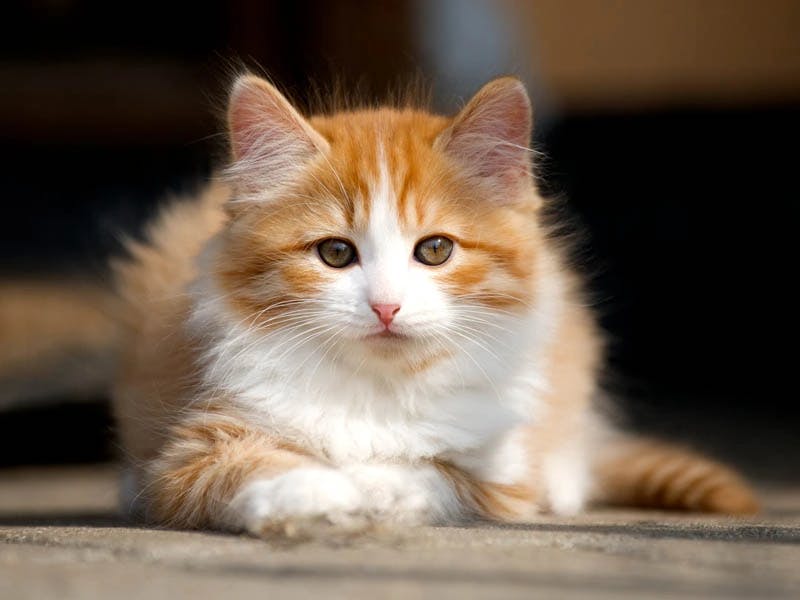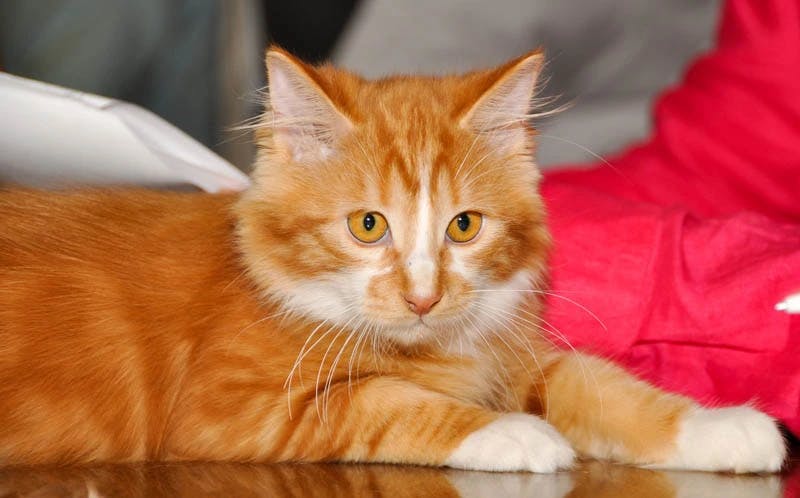Cymric
The Cymric Cat is Like a Manx with Longer Hair
Cymric
Antonia Cirjak -Last updated December 18th, 2021
Things you Should Know about the Cymric
The Cymric (pronounced kim-rick) is a cat breed that is best described as the longhaired variety of the Manx cat.
These two breeds are identical. The only difference is their coat length.
Just like the Manx, the Cymric does not have a tail. This is the result of a genetic mutation, something that occurs quite often in felines.
Still, despite being considered tailless, some Cymric cats can have up to three vertebrae fused at the end of their spines. Others can even have stumps that are up to five vertebrae long.

Appearance Matters. What does a Cymric look like?
Cymrics are medium to large in size, solid and muscular. Adult males weigh anywhere between 9lbs and 12lbs, while females weigh from 7lbs to 11lbs.
Their cheek jowls make their faces seem round, they have a rounded head, and their eyes are round as well.
Cymric cats have dense fur that is medium long, placed evenly throughout the entire body. This emphasizes the rounded appearance even further.
With age, the hair on some body parts gets longer, most notably the neck ruff and abdomen. The fur of these cats is soft and silky and changes with the seasons, meaning it gets shorter in the Summer.
Do Cymric Cats have Tails?
Some do have tails that are shorter than expected but still longer than stumps. We call these Cymric cats longys. Those without tails are called rumpys.
If you plan on taking yours to a cat show, the preferred look is tailless. If they don’t have a tail, these cats will usually have a small dimple at the base of their spine, at the place where the tail would normally start.
A Cymric with a short knob of a tail can still compete at cat shows under one condition. The stump of the tail must not stop the judge’s hand while they are petting the cat.
Kittens that have longer tails usually have them docked. People do not do this solely for cosmetic reasons. Cymrics that have longer tails are prone to experiencing arthritis once they get older.
This is caused by ossification and can cause these cats a lot of pain, which is why it is better to get rid of the tail. Predicting what type of tail will appear in a litter is impossible.
What colors do the Cymric cats come in?
Cymric cats can come in a variety of colors, except those that are from hybridization. Colors like chocolate, lavender, or a combination with white won’t appear in this breed.
Here are some of the more popular colors:
- Red
- Cream
- Silver
- White
- Blue
- Black
- Tortoiseshell
- Blue cream
- Brown
- Bicolor,
- Tricolor/Calico
- Tabby
- Smoke
Their eyes are gold, hazel, copper, green, blue, or they can be odd-eyed. It all depends on their color and coat pattern.
It's all Personal. The Cymric Temperament
Originally these cats were mousers, and they have retained their hunting skills and alert nature throughout the years. Usually, they are quite mellow, affectionate, and have an even temper.
Cymric cats prefer spending their time in calm, quiet surroundings. However, they also like to be active and can become quite playful.
These cats will follow you around the house once they have taken a liking to you.
When you sit down, expect the Cymric to jump in your lap and take a nap. If it can’t get to your lap, expect it to curl up somewhere near you. These cats like to keep their eyes on you at all times.
Their nature is adaptable, especially if you expose them to a lively environment from a young age. They will start to enjoy meeting new people, will even greet them with a head butt, and can always adapt to a new home if necessary.
Caring for your Cymric
The coat of a Cymric cat is easy to groom. Just comb or brush it twice per week, and you will be fine.
During the spring and fall seasons, it is recommended to brush them a bit more often. Naturally, since they shed, these cats are not hypoallergenic.
You should brush their teeth regularly. This will prevent periodontal disease. You should do this daily, but try to do it at least a few times per week if that isn’t possible. Also, remember to wipe the corners of their eyes using a soft, damp cloth. Do this every day to remove discharge.
You should also remember to check their ears. Clean them if they are dirty, but don’t use cotton swabs. Use a cotton ball or a damp cloth instead.

The Health and Happiness of your Cymric
The genetic mutation responsible for the tailless look of the Cymrics and Manx can be lethal for them. If the kittens inherit two copies of this gene, they die before birth.
They will often be absorbed while still in utero. This happens to almost 25% of all kittens, which is the reason why Cymric litters are usually small.
Cats that have just one copy of the gene can fall victim to the Manx syndrome, which causes gaps in the vertebrae. These gaps are called spina bifida, and they can cause vertebral dysfunction or even fused vertebrae.
Cats suffering from these conditions will often hop around like rabbits.
You will generally start to notice most issues within the first six months of age. If you visit the vet regularly, these cats can live anywhere from 8 to 14 years.
How Much Money Does a Cymric Cost?
These longhaired gorgeous kittens will easily melt your heart. This means that the fact that you’re looking at their prices should come as no surprise.
We have good news for you, as the price of Cymric kittens for sale ranges between $300 and $600. This makes these cats affordable for just about any family looking for a pet.
These are prices from reputable breeders as well, so you will know you are getting a kitten with a good pedigree. You can always check our website if you’re interested in finding the best Cymric cat breeders.
Feline History. Where does the Cymric come from?
The Cymric cats, as well as the Manx, are native to the Isle of Man, located off the coast of Britain. They most likely originated around the year 1750.
Because of centuries of inbreeding in an isolated environment, the taillessness became permanent. This is how the Cymric and the Manx we know today came to be, even though they both existed before ultimately losing their tails because of the mutation.
Cymric cats were officially recognized by the Cat Fanciers’ Association in 1994, and only as a division of the Manx.
There are even some associations that consider it a long-haired Manx. However, most recognize that it is a separate breed.
